Galaxy A50 vs. Pixel 3a: Which Bargain Smartphone Wins?
Samsung's Galaxy A50 and Google's Pixel 3a are two of the best midrange phones out there. Here's how they stack up.
The ever-growing arena of midrange smartphones has become a lot more competitive. Google has released its $399 Pixel 3a and $479 Pixel 3a XL, two handsets that actually keep parity with a lot of the more desirable features of Google's flagship Pixel 3 and 3 XL, while costing half the price of those models.
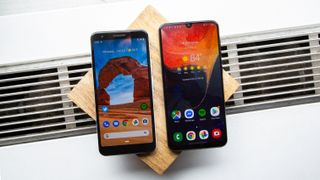
Not to be outdone, Samsung has followed up with the extremely compelling Galaxy A50. At $349, the A50 is $50 cheaper than Google's device and, on paper at least, appears to either match the Pixel 3a or best it in a number of key areas, including its OLED display, triple-lens camera system and premium-looking design.
One thing's for certain — both devices are a steal, and either would be an excellent choice for someone who doesn't necessarily need the most power and performance. Which sub-$400 handset is the better option for you? Our Galaxy A50 vs. Pixel 3a face-off has the answer.
Galaxy A50 vs. Pixel 3a Specs
| Samsung Galaxy A50 | Google Pixel 3a | |
| Price | $349 | $399 |
| Supported networks | Verizon, Sprint | Verizon, T-Mobile, Sprint, Unlocked |
| Display (resolution) | 6.4-inch AMOLED (2340 x 1080) | 5.6-inch OLED (2220x1080) |
| CPU | Samsung Exynos 9610 | Qualcomm Snapdragon 670 |
| RAM | 4 GB | 4 GB |
| Storage | 64 GB | 64 GB |
| Rear camera(s) | Triple: 25-MP wide (ƒ/1.7); 8-MP ultrawide (ƒ/2.2); 5-MP depth sensor (ƒ/2.2 | 12.2 MP (ƒ/1.8) |
| Front camera(s) | 25-MP (ƒ/2.0) | 8 MP (ƒ/2.0) |
| Expandable storage | Yes, up to 512 GB | None |
| Water resistance | None | None |
| Battery | 4,000 mAh | 3,000 mAh |
| Battery life (hrs:mins) | 9:37 | 11:59 |
| Colors | Black | Clearly Black, Clearly White, Purple-ish |
| Size | 6.24 x 2.94 x 0.30 inches | 5.96 x 2.76 x 0.32 inches |
| Weight | 5.86 ounces | 5.19 ounces |
Design
The first difference you notice between the Galaxy A50 and Pixel 3a pertains to their proportions. Google's handset is a compact, traditional-looking smartphone with a 5.6-inch display set in prominent bezels, whereas Samsung's gigantic A50 opts for a 6.4-inch panel and a notch. Google does of course sell the larger 6.3-inch Pixel 3a XL, though that device demands a $80 premium over the smaller variant.

The Galaxy A50 is actually a hair thinner than the Pixel 3a, but in every other dimension, Samsung's is the larger device. There are other differences to note as well. For one, the A50 sports an in-screen optical fingerprint sensor, whereas the Pixel 3a goes with a tried-and-true capacitive module.
Samsung's offering also features three cameras on the back to Google's one, and while both handsets are made of plastic, the A50 opts for a flashier blackish-gray metallic sheen that reflects rainbows. The Pixel 3a, on the other hand, can be had in a choice of three solid colorways: Clearly Black, Clearly White and our favorite, Purple-ish. Thankfully, no matter which you choose, you'll get a 3.5-millimeter headphone jack.

If you're judging design strictly by which of these handsets looks more like today's most expensive flagships, the winner here has to be the Galaxy A50. Samsung's gifted its midranger with razor-thin bezels, an Infinity-U notched display and a fingerprint sensor that is a little finicky, but ultimately where the industry is headed.
However, there's no denying elements of the A50, particularly that plastic back panel, do feel a bit cheap compared to those of the high-end models Samsung is trying to evoke. And the Pixel 3a is actually very strong in this regard — the mix of matte and glossy surfaces on the device's body feels like a quality touch, and the splash of color from the power key on the Clearly White and Purple-ish models gives the 3a a playful bit of flair the more serious A50 lacks. Ultimately, Samsung's device wins this category overall, but Google's finer details earn it some points.
Winner: Galaxy A50
Display
OLED displays are finally falling in price, to the point where Samsung and Google can put them in sub-$400 devices.
That's tremendously exciting, though the OLED panels in the Galaxy A50 and Pixel 3a are actually quite different. Even aside from size — the A50's screen measures 6.4 inches, while the Pixel 3a's is 5.6 inches — Samsung's screen bests Google's efforts across the board.

The A50's screen gets significantly brighter than the Pixel 3a's, topping out at 574 nits versus 401 nits. That'll be extremely useful when using the phone outside on a sunny day. The A50 can also render a larger swath of the sRGB color space, at 193 percent compared with the Pixel 3a's 182 percent.
Samsung's handset delivered a slightly worse Delta-E color accuracy rating of 0.74 against Google’s 0.18 (numbers closer to zero are better). Yet overall, the AMOLED display in the A50 is one of its finest qualities. It even offers a few alternate color profiles, so you can calibrate the display to your liking.
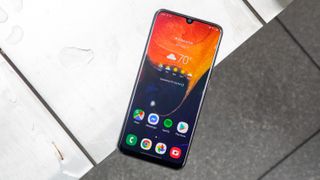
I also notice there's a bit of a warm cast present in content on the Pixel 3a's screen that I don't pick up from the A50. It's not so strong that it would turn me away from the 3a completely. Given the choice between the two, Samsung's panel has more going for it.
Winner: Galaxy A50
Camera
The cameras in the Galaxy A50 and Pixel 3a couldn't be more different. Where Samsung provides three shooters on the back of the A50 — a 25-megapixel wide-angle lens, 8-MP ultrawide one and 5-MP depth sensor — the rear of the Pixel 3a houses a lone 12.2-MP camera.

That may make it seem like the odds are heavily stacked in Samsung's favor, but Google has an ace up its sleeve. As it turns out, the optics and software inside the Pixel 3a are pretty much indistinguishable from those in the more premium Pixel 3. As a result, Google's midrange offering absolutely runs away from the competition here.
The A50's shot above, captured inside Tom's Guide’s office, is perfectly adequate for a cheap phone. However, when you compare it to the Pixel 3a's interpretation of the same scene, you can begin to see Google's flagship-caliber imaging shine through. The greenish cast from Samsung's camera is gone, and the details in the leaves and text on the books are more legible.
The A50 really began to struggle when I attempted to capture a shallow depth-of-field portrait of my colleague Jorge. Samsung's Live Focus software already has a tendency to smudge details even on the Galaxy S10, and the same is definitely true of the company's new budget device. However, the blurring here is far too strong, making it look almost as if the camera were not properly focused, or shaken during capture, or like some kind of beautification filter was turned on. The Pixel 3a's attempt suffers from none of these setbacks.
Google'’s Night Sight mode explains the fact that the Pixel 3a's shot here, taken inside our nearly pitch-black video studio, is actually visible, while the Galaxy A50's fruitless attempt is shrouded in complete darkness. Samsung does offer a mode called Bright Night on the Galaxy S10 series, though evidently the phone maker couldn't figure out a way to pack that functionality into the cheaper A50.
Finally, the Pixel 3a's front-facing 8-MP shooter proved better for taking selfies, even though it captures a third of the resolution of Samsung's 25-MP front camera. Once again, the A50 strongly favors brightness over detail to a fault, resulting in washed-out hues and a distinct lack of sharpness.
Winner: Pixel 3a
Performance and specs
The Exynos 9610 chipset that powers the Galaxy A50 squares up nicely against the Pixel 3a's Snapdragon 670 silicon. Both processors are supported by 4 GB of RAM as well.
If you look at numbers, the Galaxy just edged the Pixel in Geekbench 4, which tests overall performance, by a score of 5,200 to 5,146. However, the opposite scenario played out when we launched 3DMark's Sling Shot Extreme Open GL ES 3.1 graphics benchmark on both phones. That time, it was the Pixel 3a ahead by a hair, turning in a 1,602 score, compared with the A50's 1,312.
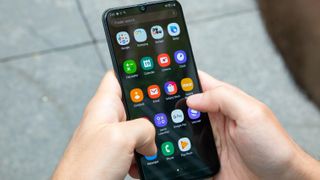
Given the similarities from a hardware perspective, the gap in performance between these two phones might be more a matter of optimization. And to that end, the Pixel 3a seemed a bit snappier on average during everyday use. In my experience, the A50 sometimes lagged in redrawing the home screen after unlocking, or loading up Spotify from the lock screen when tapping on a notification.
However, the A50 has something the Pixel 3a doesn't: a microSD slot, allowing users to add up to 512 GB of extra space to their device. That makes a big difference — one that arguably offsets Google's slight performance advantage.
Winner: Tie
Battery life
The Galaxy A50 comes equipped with a much larger battery than the Pixel 3a, rated at 4,000 mAh to the Google phone's 3,000 mAh. Still, the A50 has a much larger screen to light up.
That might explain why the A50 performed worse in our proprietary battery test, where we task phones with endlessly loading web pages over LTE until they run out of juice. There, Samsung’s handset lasted a decent 9 hours and 37 minutes, while the Pixel 3a far surpassed it at 11 hours and 59 minutes.

The Pixel 3a also is a bit quicker to top up, thanks to 18W Power Delivery charging that gets the phone from empty to about 40 percent in 30 minutes. The A50's 15W charging can't quite match that, hitting 30 percent in that same period of time, further tilting the battery round in Google's favor.
Winner: Pixel 3a
Software and special features
Both handsets run Android 9 Pie, though the experience of using each of them is very different.
Samsung's OneUI replaces the stock Android interface on the Galaxy A50, and adds some useful features in the process, like the ability to take scrolling screenshots and lock apps and files inside a password-protected folder. Samsung also offers an optional gesture-based interface on the A50 that allows the entire screen to show content without a navigation bar — something Android Pie on the Pixel 3a lacks.
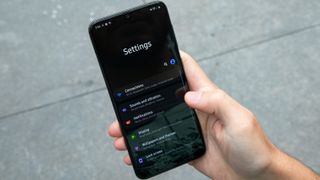
However, Google's software is a bit more intuitive and streamlined, and has some benefits of its own. That includes Call Screen, which arrived on the Pixel 3a after launching on the Pixel 3 and uses the Google Assistant to respond to unknown callers for you. There's also the aforementioned Night Sight camera mode, which greatly improves low-light photography.
Additionally, Google has already committed to three years of software updates for the Pixel 3a. And because it's a Pixel phone, you can expect the quickest possible updates to new versions of Android, likely well before those same updates arrive for Galaxy users.

Google's long-term support for the Pixel 3a assures buyers that they won't be left in the lurch and miss out on new functionality over the phone's life span, earning it our recommendation here. However, the A50 keeps the race close, thanks to a handful of extra features in OneUI that are still missing in Google's software.
Winner: Pixel 3a
Pricing and availability
At the moment, the Galaxy A50 is only available through Verizon and Sprint for $349. Samsung isn't selling the device unlocked yet, and we don't know if it intends to in the future.
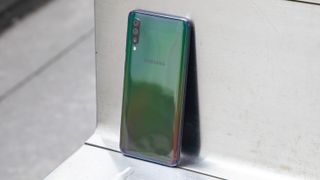
The Pixel 3a and 3a XL go for $399 and $479 and are available through Verizon, T-Mobile, Sprint and Google Fi as well as unlocked from the Google Store. The unlocked versions of the 3a and 3a XL will work on pretty much any carrier, as they're compatible with both CDMA and GSM networks. Later in July, Verizon's new prepaid carrier Visible will begin offering both sizes of the Pixel 3a as well.
The Galaxy A50 is a tad cheaper, but the Pixel 3a is more widely available and compatible with more networks — making it easier for everyone to buy.
Winner: Pixel 3a
Winner: Pixel 3a
The Galaxy A50 and Pixel 3a are the best things to happen to midrange phones in quite a while. If you have only $400 to spend on a device, you could do very well with either one.
| Samsung Galaxy A50 | Google Pixel 3a | |
| Design (10) | 8 | 7 |
| Display (10) | 9 | 7 |
| Camera (25) | 17 | 23 |
| Performance and specs (15) | 12 | 12 |
| Battery life (20) | 13 | 17 |
| Software and special features (10) | 8 | 9 |
| Price and availability (10) | 8 | 9 |
| Total (100) | 75 | 84 |
If you're swayed by the Galaxy A50's brighter screen or more modern design, we wouldn't advise you against taking it over the Pixel 3a — especially because Samsung's midrange handset is $50 cheaper, and the 6-inch Pixel 3a XL is a whopping $130 more expensive than the A50.
However, the Pixel 3a gets our overall endorsement in this faceoff because it gets more right. Its camera is easily the best you can buy for the money; its battery lasts longer on a charge; its software guarantees more long-term support; and it will work with any carrier if you choose to go unlocked. And we believe that’s worth the extra $50.
Credit: Tom's Guide
Sign up to get the BEST of Tom’s Guide direct to your inbox.
Upgrade your life with a daily dose of the biggest tech news, lifestyle hacks and our curated analysis. Be the first to know about cutting-edge gadgets and the hottest deals.
Adam Ismail is a staff writer at Jalopnik and previously worked on Tom's Guide covering smartphones, car tech and gaming. His love for all things mobile began with the original Motorola Droid; since then he’s owned a variety of Android and iOS-powered handsets, refusing to stay loyal to one platform. His work has also appeared on Digital Trends and GTPlanet. When he’s not fiddling with the latest devices, he’s at an indie pop show, recording a podcast or playing Sega Dreamcast.
